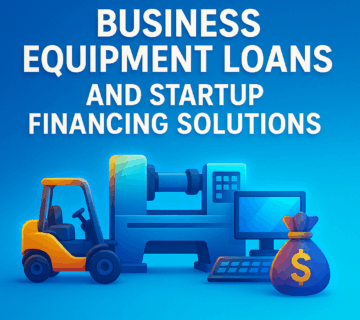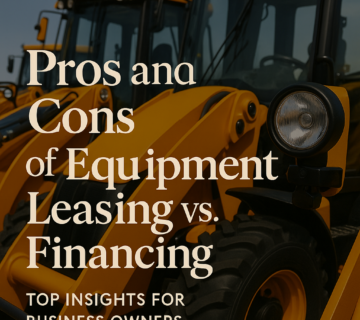How Technology is Changing the Equipment Financing Industry
Introduction
The equipment financing industry has seen remarkable advancements in recent years due to rapid technological innovations. Traditional lending processes, which often involved cumbersome paperwork and lengthy approval times, have been transformed through artificial intelligence (AI), big data, blockchain, and cloud computing. These technologies have made business equipment financing more efficient, accessible, and secure.
For businesses, securing financing for essential equipment is crucial for growth. Whether it’s equipment rental finance, heavy equipment financing, or securing equipment loans for small businesses, technology has made the entire process faster and more transparent.
In this article, we will explore how technology is reshaping the equipment finance company landscape and the key benefits of equipment financing for businesses looking to invest in machinery, vehicles, and other critical assets.
1. The Digital Transformation of Equipment Financing
1.1 From Traditional to Digital Lending
In the past, securing financing for equipment required businesses to complete extensive paperwork, provide physical financial records, and undergo manual underwriting processes. Today, digital lending platforms have significantly streamlined this process.
With online application portals, businesses can now apply for equipment loans for small businesses within minutes, upload required documents digitally, and receive approval in a fraction of the time compared to traditional banks.
1.2 AI-Driven Underwriting and Risk Assessment
One of the most significant innovations in business equipment financing is AI-powered underwriting. Traditional underwriting methods relied on manual evaluation, which was time-consuming and sometimes inaccurate. AI systems now analyze real-time financial data, cash flow patterns, and industry trends to assess borrower risk more effectively.
For instance, an equipment finance company using AI-based risk assessment can quickly determine the creditworthiness of a borrower by analyzing their financial health and past transactions, reducing approval times and improving loan accessibility.
2. Big Data and Predictive Analytics in Equipment Financing
2.1 Enhanced Decision-Making for Lenders
Big data analytics allows lenders to make informed decisions based on a broader range of financial indicators. By analyzing credit scores, business cash flows, and market trends, lenders can customize heavy equipment financing options that suit a borrower’s specific needs.
For example, a construction company applying for financing for equipment such as bulldozers and cranes can benefit from tailored loan terms that align with its projected revenue cycles.
2.2 Fraud Detection and Prevention
Fraud remains a significant challenge in the equipment finance company sector. Machine learning and predictive analytics can detect fraudulent loan applications by identifying inconsistencies in financial records.
For example, if an applicant submits false revenue statements, AI-powered systems can cross-reference this data with industry benchmarks and flag potential fraud before loan approval.
3. Blockchain and Smart Contracts in Equipment Financing
3.1 Increased Transparency and Security
Blockchain technology has brought enhanced transparency and security to business equipment financing by recording transactions on a decentralized ledger. This eliminates discrepancies and ensures that loan agreements remain tamper-proof.
With blockchain, both borrowers and lenders can track repayment schedules, interest calculations, and contract terms in real time, reducing disputes and increasing trust.
3.2 The Role of Smart Contracts
Smart contracts, powered by blockchain, are self-executing contracts that automatically enforce financing agreements. These contracts are particularly beneficial in equipment rental finance, where payments are automatically processed based on predefined conditions.
For example, if a business secures a lease for construction equipment, a smart contract can automate lease payments and adjust terms based on usage patterns, streamlining the entire heavy equipment financing process.
4. Cloud Computing and Its Role in Equipment Financing
4.1 Cloud-Based Loan Management Systems
Cloud computing has enabled lenders to offer more flexible and scalable solutions in financing for equipment. Cloud-based loan management systems provide:
- Secure storage of borrower data
- Real-time access to loan applications
- Automated payment processing
These systems improve efficiency and allow businesses to manage their equipment loans for small businesses from anywhere in the world.
4.2 Cost Savings and Scalability
For lenders, cloud computing reduces IT infrastructure costs, allowing them to scale their business equipment financing services without large upfront investments. This leads to lower loan processing fees, which benefits borrowers seeking affordable financing.
5. FinTech Disruption in Equipment Financing
5.1 Alternative Lending Platforms
FinTech companies have introduced new ways to access financing for equipment, bypassing traditional banks and offering faster approval processes. Platforms like Kabbage and Funding Circle use AI-driven credit assessments to approve loans quickly, making it easier for small businesses to secure funding.
5.2 Peer-to-Peer (P2P) Equipment Financing
P2P lending platforms have also revolutionized the industry by allowing businesses to borrow directly from investors. These platforms often provide more flexible terms than traditional banks, making business equipment financing more accessible to startups and small enterprises.
6. The Future of Equipment Financing: Emerging Trends
6.1 AI-Powered Virtual Assistants
AI-powered chatbots and virtual assistants are being integrated into lending platforms to assist businesses in applying for equipment loans for small businesses. These AI assistants can provide instant loan estimates, explain financing options, and guide applicants through the process.
6.2 Embedded Financing in E-Commerce
Embedded financing is becoming a game-changer in equipment rental finance. Online marketplaces and equipment suppliers now offer built-in financing options, allowing businesses to secure loans at the point of sale.
For instance, a company purchasing industrial machinery online can apply for business equipment financing directly through the e-commerce platform, simplifying the process.
6.3 Decentralized Finance (DeFi) in Equipment Financing
Decentralized finance (DeFi) platforms are expected to further disrupt heavy equipment financing by offering blockchain-based, peer-to-peer lending without traditional intermediaries. DeFi solutions can provide faster approvals and lower interest rates compared to banks.
7. Benefits of Equipment Financing
The benefits of equipment financing extend beyond just acquiring essential business assets. Some key advantages include:
- Preserving Cash Flow: Instead of paying a large upfront cost, businesses can spread payments over time.
- Tax Advantages: Many equipment loans offer tax deductions, helping businesses save money.
- Access to the Latest Technology: Financing allows companies to upgrade to newer equipment without large capital investments.
- Flexible Terms: Lenders offer various repayment options tailored to business needs.
Whether a company needs heavy equipment financing for construction or equipment rental finance for temporary projects, technological advancements have made financing more accessible and beneficial than ever.
Conclusion
Technology has drastically reshaped the equipment finance company landscape, making it more efficient, secure, and accessible. AI-powered underwriting, big data analytics, blockchain transparency, and cloud-based loan management systems have all contributed to a more streamlined and borrower-friendly environment.
As new trends like embedded financing, P2P lending, and DeFi solutions continue to emerge, business equipment financing will become even more flexible and efficient. Companies that embrace these technological advancements will gain a competitive edge by securing faster approvals, lower costs, and better financing options tailored to their needs.
FAQs
1. How is AI changing the equipment financing industry?
AI automates underwriting, enhances risk assessment, and improves fraud detection, making the approval process faster and more reliable.
2. What are the benefits of equipment financing for small businesses?
Small businesses can access necessary equipment without large upfront costs, preserve cash flow, and take advantage of tax benefits.
3. How does blockchain improve equipment financing?
Blockchain ensures secure and transparent transactions, reducing fraud risks and enabling smart contracts for automated loan agreements.
4. What is embedded financing in equipment purchases?
Embedded financing allows businesses to apply for loans directly through e-commerce platforms when purchasing equipment.





No comment